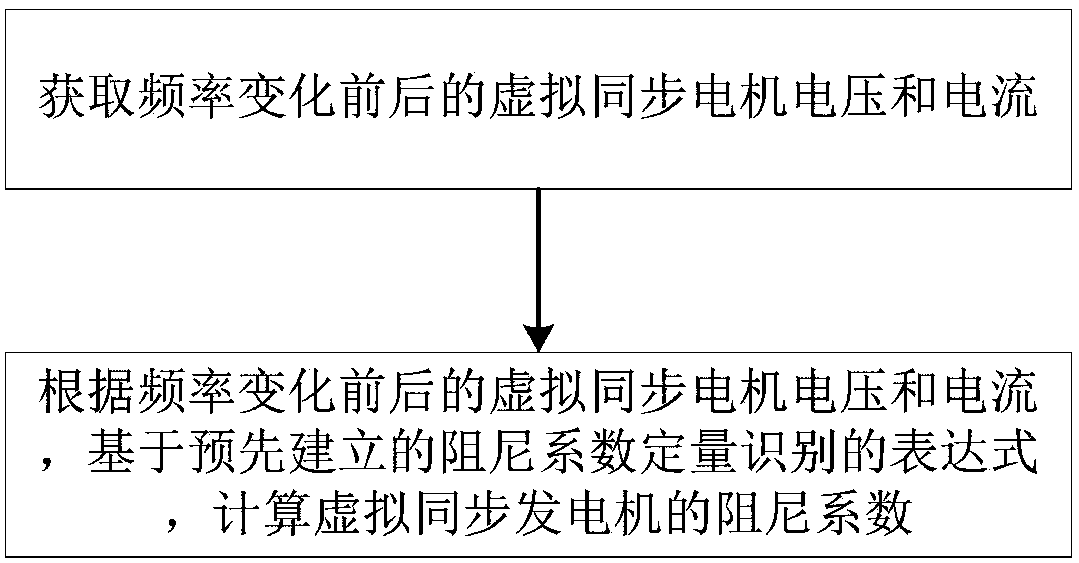Damping coefficient quantitative identification method, system and device for virtual synchronous generator
A technology of virtual synchronous motor and damping coefficient, which is applied in the direction of circuit devices, electrical components, AC network circuits, etc., to achieve the effect of optimizing grid-connected performance
- Summary
- Abstract
- Description
- Claims
- Application Information
AI Technical Summary
Problems solved by technology
Method used
Image
Examples
Embodiment 1
[0065] The present invention provides a method for quantitatively identifying the damping coefficient of a virtual synchronous generator, the flow chart of which is as follows figure 1 As shown, the method may include:
[0066] S11. Obtaining the voltage and current of the virtual synchronous motor before and after the frequency change;
[0067] S12. Calculate the damping coefficient of the virtual synchronous generator according to the voltage and current of the virtual synchronous motor before and after the frequency change, and based on a pre-established expression for quantitative identification of the damping coefficient.
[0068] In step S11, the virtual synchronous generator simulates the operating mechanism and external characteristics of the traditional synchronous motor through the inverter control algorithm, so that the inverter power supply has inertia response and damping characteristics, and provides frequency and voltage support for the stable operation of the s...
Embodiment 2
[0084] In order to quantitatively identify and obtain the damping coefficient, further experiments are needed to collect the voltage and current of the VSG before and after the frequency change.
[0085] with attached figure 2 The grid simulation device shown provides conditions for the test to be carried out, including: a grid simulation device and an acquisition device; the acquisition device is arranged between the grid simulation device and the virtual synchronous generator, and the virtual synchronous generator passes through The power grid simulation device is connected to the power grid; the collection device includes a voltage transformer and a current transformer; the voltage transformer is used to collect the voltage of the virtual synchronous generator; the current transformer is used to collect the current of the virtual synchronous generator;
[0086] The power grid simulation device includes: a step-down transformer, a rectifier, an inverter, an inverter control...
Embodiment 3
[0093] Based on the same inventive concept, the present invention also provides a quantitative identification system for the damping coefficient of a virtual synchronous generator, including:
[0094] Establishing a module for pre-establishing the expression of the quantitative identification of the damping coefficient;
[0095] The obtaining module is used to obtain the voltage and current of the virtual synchronous motor before and after the frequency change;
[0096] The calculation module is used to calculate the damping coefficient of the virtual synchronous generator based on the pre-established quantitative identification expression of the damping coefficient according to the voltage and current of the virtual synchronous motor before and after the frequency change.
[0097] Further: the building module includes:
[0098] The determination unit is used to determine the rotor motion equation of the virtual synchronous motor, and at the same time use the micro power inve...
PUM
 Login to View More
Login to View More Abstract
Description
Claims
Application Information
 Login to View More
Login to View More - R&D
- Intellectual Property
- Life Sciences
- Materials
- Tech Scout
- Unparalleled Data Quality
- Higher Quality Content
- 60% Fewer Hallucinations
Browse by: Latest US Patents, China's latest patents, Technical Efficacy Thesaurus, Application Domain, Technology Topic, Popular Technical Reports.
© 2025 PatSnap. All rights reserved.Legal|Privacy policy|Modern Slavery Act Transparency Statement|Sitemap|About US| Contact US: help@patsnap.com



